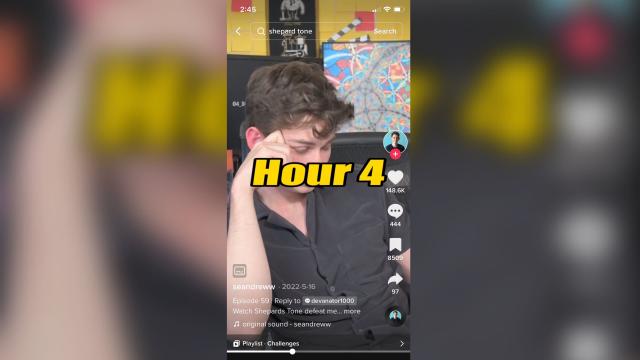I am writing this article while under the influence of what TikTokers are calling “audio torture.” There are many versions of the torturous sound to choose from, and mine is this one, which features a warning in its YouTube title (“video and audio can have psychological effects”). Will it actually make me go crazy? Let’s see.
The sounds that TikTokers have labelled torture are different versions of what’s known as a Shepard tone. Please note that this discussion does not apply to audio recordings of torture, which are probably also out there; the Shepard tone is an audio illusion, a track that seems to grow higher and higher in pitch even when you play it on a loop.
The Shepard tone, and similar soundtracks, are not new. Here is a paper tracing the phenomenon as it has been used in musical compositions since the 1500’s. They call it “pitch circularity.”
The basic idea is this: Several tones are played at the same time, typically an octave apart from one another. Each of these tones gets higher and higher — imagine each as a musician in an orchestra, and they are all playing scales together, some an octave higher than others. Obviously the pitch can’t rise forever, since there is a limit to how high an instrument can play (or the human ear can hear). But because there are several tones rising in parallel, our ear follows the rise from one octave, to the next, to the next, even though each individual instrument in the loop is only playing one octave and then resetting to the beginning.
There’s another trick necessary to make this work as an infinite loop. To stop our brains from catching on, you subtly fade out the highest tone as it reaches its zenith, and fade in on the lowest one as it enters. As the higher tones fade out, your brain begins paying more attention to the tones in the middle. The effect: a sustained note that seems to rise forever.
You can, of course, do the same thing with a falling tone. Here’s a smoothed-out example, called a Shepard-Risset glissando:
So where does TikTok come in? I’ll credit this one to the creativity of the youths of today. In my day, we would say, “have you heard of the Shepard tone? Check this out,” and then play a few seconds of a clip. “Yep, that’s weird,” our friend would say, and then we would get off the Internet because someone was probably waiting to make a phone call.
Today’s TikTokers, by contrast, are challenging themselves to endure hours of listening to the circular pitch of their choice, amid hyperbole that the soundtrack will “literally drive you insane” or warnings that “you won’t be able to listen to this without going crazy.” They sometimes list symptoms like nausea or panic attacks as potential side effects of listening to the tone.
It’s true that it feels weird as hell to listen to. I’m still listening to the rising one, and it’s like that moment of heightened suspense in a movie where you’re just waiting for the jump scare…except the jump scare never comes. Some studies find that people sometimes feel a sensation of falling if they listen long enough, but I wasn’t able to confirm that such a sound will, “drive you insane.”
The TikTokers tend to suffer for their art, but usually only to the point of being bored and annoyed. Sometimes a few hours in, they take a nap. Kudos to this guy for waking up, restarting the sound from the approximate time he fell asleep, and cranking up the volume to max for a dramatic finish. (He was fine.)
By the way, the examples we have of actual CIA torture involving music involve real songs. Detainees would be kept in the dark but prevented from sleeping thanks to tracks like the theme songs to Rawhide and Barney and Friends theme being played at high volume. As for myself, I’m looking forward to stopping the Shepard tone loop as soon as I file this story, but I still haven’t gone insane. Unless you count the fact that at this point, I would probably be happy to listen to the Barney theme for a while instead.

Leave a Reply
You must be logged in to post a comment.